People Management Report: Tesco's Strategies and Analysis
VerifiedAdded on 2020/10/05
|14
|4622
|129
Report
AI Summary
This report provides a comprehensive analysis of people management practices within Tesco, a multinational grocery retailer. It begins with an introduction outlining the importance of effective workforce management for organizational success. The report then delves into key areas such as organizational structure and its impact on employees, exploring Tesco's hierarchical structure and its effects. It examines the company's culture and its influence on employees' behavior and performance. The analysis includes an examination of different leadership styles, including autocratic and democratic approaches, and their effects on individuals and teams. The report further investigates what it's like to work for Tesco, highlighting factors like flexible working hours and a positive work environment. It then explores the benefits of flexible working practices for both individuals and the organization. The report also analyzes the impact of the working environment on employee performance, referencing motivation theories. Additionally, it examines ethical practices and CSR agendas within Tesco, including how these agendas are used to motivate employees. The report concludes with recommendations based on the analysis and understanding of the practices.
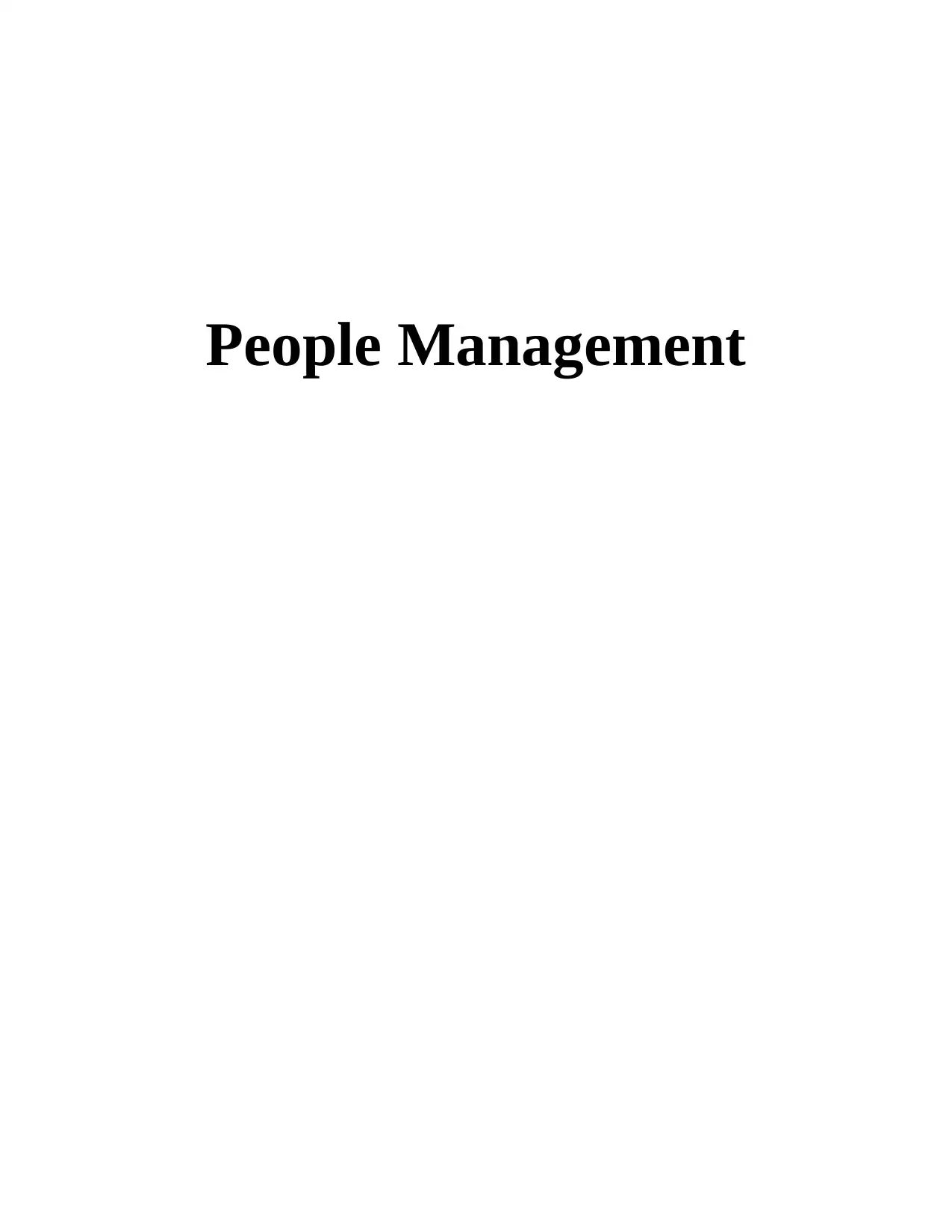
People Management
Paraphrase This Document
Need a fresh take? Get an instant paraphrase of this document with our AI Paraphraser
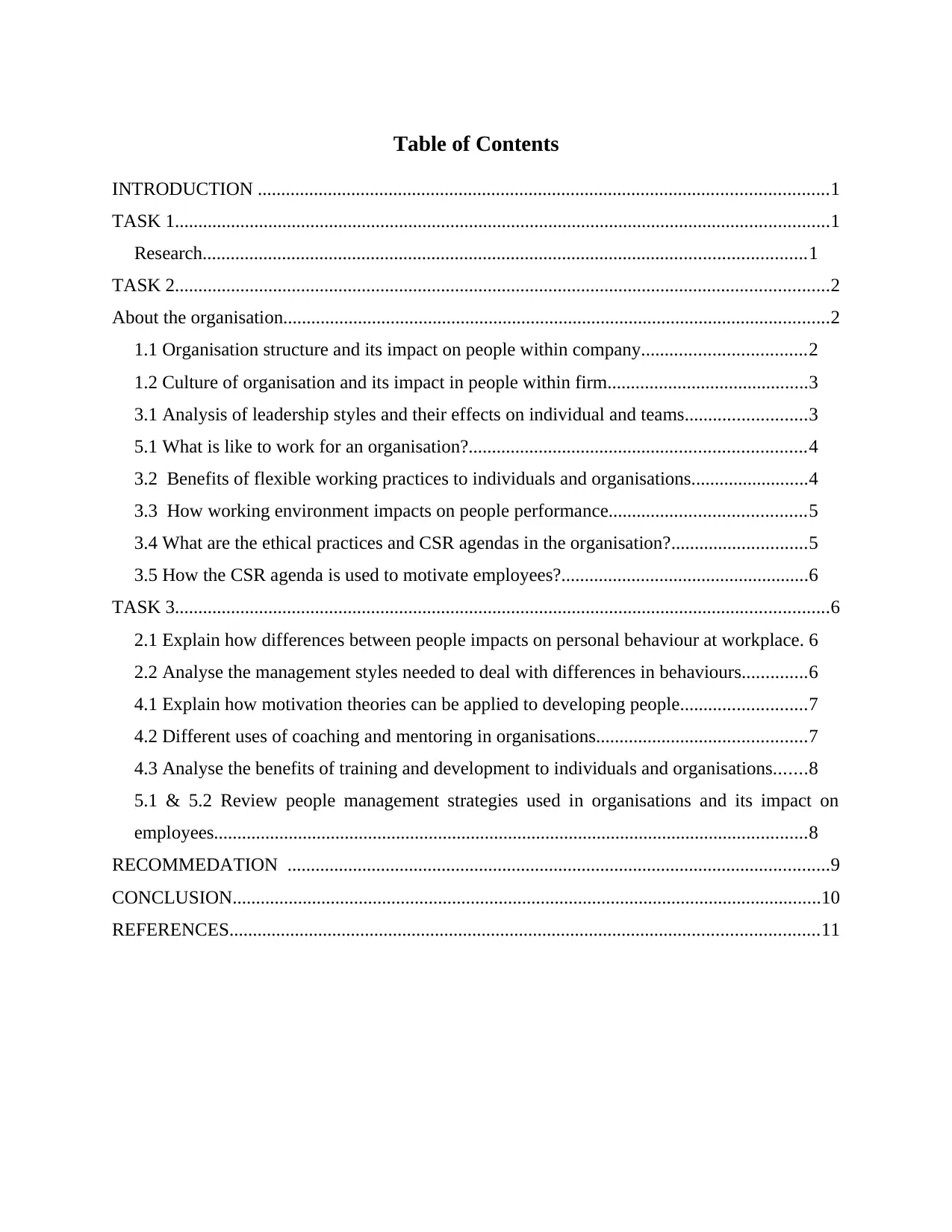
Table of Contents
INTRODUCTION ..........................................................................................................................1
TASK 1............................................................................................................................................1
Research.................................................................................................................................1
TASK 2............................................................................................................................................2
About the organisation.....................................................................................................................2
1.1 Organisation structure and its impact on people within company...................................2
1.2 Culture of organisation and its impact in people within firm...........................................3
3.1 Analysis of leadership styles and their effects on individual and teams..........................3
5.1 What is like to work for an organisation?........................................................................4
3.2 Benefits of flexible working practices to individuals and organisations.........................4
3.3 How working environment impacts on people performance..........................................5
3.4 What are the ethical practices and CSR agendas in the organisation?.............................5
3.5 How the CSR agenda is used to motivate employees?.....................................................6
TASK 3............................................................................................................................................6
2.1 Explain how differences between people impacts on personal behaviour at workplace. 6
2.2 Analyse the management styles needed to deal with differences in behaviours..............6
4.1 Explain how motivation theories can be applied to developing people...........................7
4.2 Different uses of coaching and mentoring in organisations.............................................7
4.3 Analyse the benefits of training and development to individuals and organisations.......8
5.1 & 5.2 Review people management strategies used in organisations and its impact on
employees...............................................................................................................................8
RECOMMEDATION ....................................................................................................................9
CONCLUSION..............................................................................................................................10
REFERENCES..............................................................................................................................11
INTRODUCTION ..........................................................................................................................1
TASK 1............................................................................................................................................1
Research.................................................................................................................................1
TASK 2............................................................................................................................................2
About the organisation.....................................................................................................................2
1.1 Organisation structure and its impact on people within company...................................2
1.2 Culture of organisation and its impact in people within firm...........................................3
3.1 Analysis of leadership styles and their effects on individual and teams..........................3
5.1 What is like to work for an organisation?........................................................................4
3.2 Benefits of flexible working practices to individuals and organisations.........................4
3.3 How working environment impacts on people performance..........................................5
3.4 What are the ethical practices and CSR agendas in the organisation?.............................5
3.5 How the CSR agenda is used to motivate employees?.....................................................6
TASK 3............................................................................................................................................6
2.1 Explain how differences between people impacts on personal behaviour at workplace. 6
2.2 Analyse the management styles needed to deal with differences in behaviours..............6
4.1 Explain how motivation theories can be applied to developing people...........................7
4.2 Different uses of coaching and mentoring in organisations.............................................7
4.3 Analyse the benefits of training and development to individuals and organisations.......8
5.1 & 5.2 Review people management strategies used in organisations and its impact on
employees...............................................................................................................................8
RECOMMEDATION ....................................................................................................................9
CONCLUSION..............................................................................................................................10
REFERENCES..............................................................................................................................11
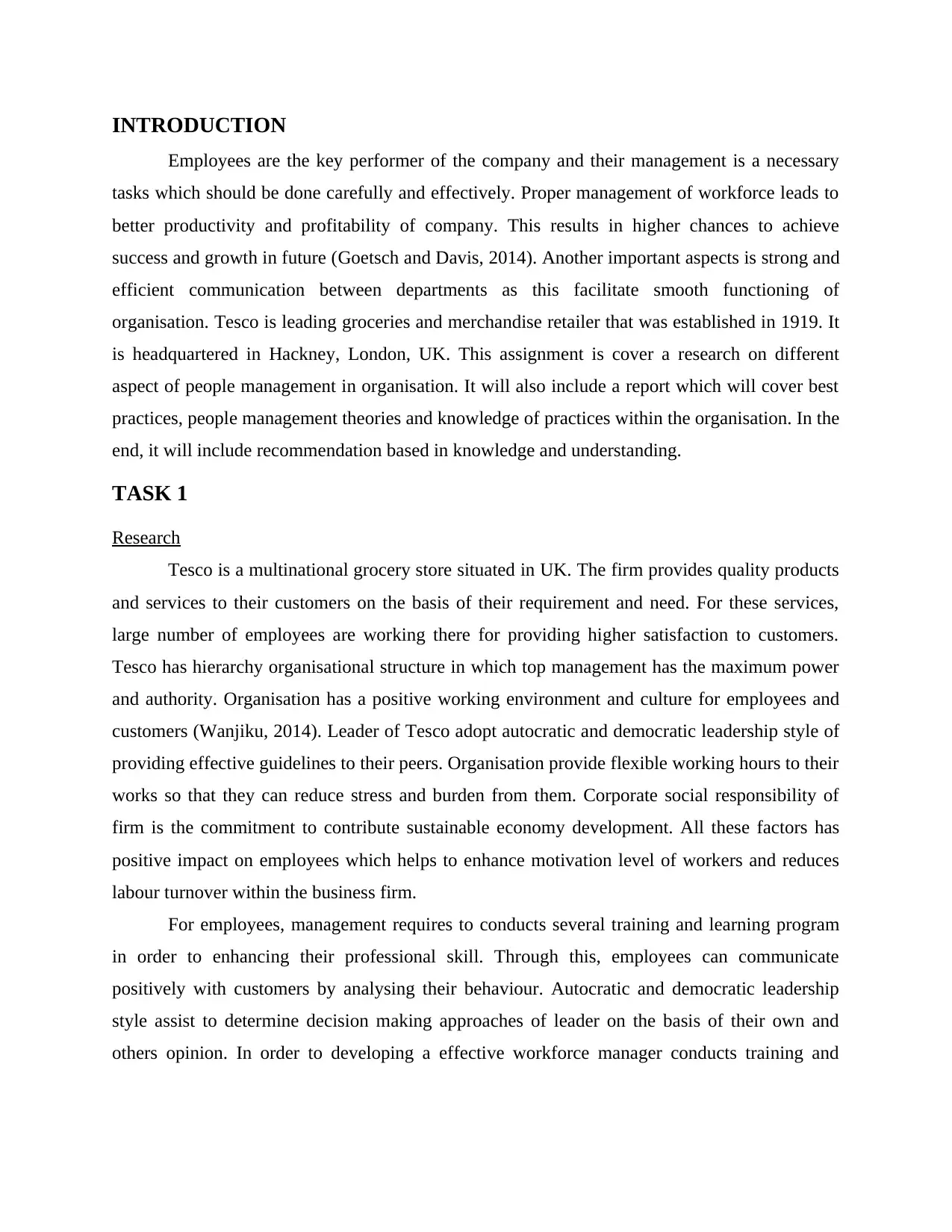
INTRODUCTION
Employees are the key performer of the company and their management is a necessary
tasks which should be done carefully and effectively. Proper management of workforce leads to
better productivity and profitability of company. This results in higher chances to achieve
success and growth in future (Goetsch and Davis, 2014). Another important aspects is strong and
efficient communication between departments as this facilitate smooth functioning of
organisation. Tesco is leading groceries and merchandise retailer that was established in 1919. It
is headquartered in Hackney, London, UK. This assignment is cover a research on different
aspect of people management in organisation. It will also include a report which will cover best
practices, people management theories and knowledge of practices within the organisation. In the
end, it will include recommendation based in knowledge and understanding.
TASK 1
Research
Tesco is a multinational grocery store situated in UK. The firm provides quality products
and services to their customers on the basis of their requirement and need. For these services,
large number of employees are working there for providing higher satisfaction to customers.
Tesco has hierarchy organisational structure in which top management has the maximum power
and authority. Organisation has a positive working environment and culture for employees and
customers (Wanjiku, 2014). Leader of Tesco adopt autocratic and democratic leadership style of
providing effective guidelines to their peers. Organisation provide flexible working hours to their
works so that they can reduce stress and burden from them. Corporate social responsibility of
firm is the commitment to contribute sustainable economy development. All these factors has
positive impact on employees which helps to enhance motivation level of workers and reduces
labour turnover within the business firm.
For employees, management requires to conducts several training and learning program
in order to enhancing their professional skill. Through this, employees can communicate
positively with customers by analysing their behaviour. Autocratic and democratic leadership
style assist to determine decision making approaches of leader on the basis of their own and
others opinion. In order to developing a effective workforce manager conducts training and
Employees are the key performer of the company and their management is a necessary
tasks which should be done carefully and effectively. Proper management of workforce leads to
better productivity and profitability of company. This results in higher chances to achieve
success and growth in future (Goetsch and Davis, 2014). Another important aspects is strong and
efficient communication between departments as this facilitate smooth functioning of
organisation. Tesco is leading groceries and merchandise retailer that was established in 1919. It
is headquartered in Hackney, London, UK. This assignment is cover a research on different
aspect of people management in organisation. It will also include a report which will cover best
practices, people management theories and knowledge of practices within the organisation. In the
end, it will include recommendation based in knowledge and understanding.
TASK 1
Research
Tesco is a multinational grocery store situated in UK. The firm provides quality products
and services to their customers on the basis of their requirement and need. For these services,
large number of employees are working there for providing higher satisfaction to customers.
Tesco has hierarchy organisational structure in which top management has the maximum power
and authority. Organisation has a positive working environment and culture for employees and
customers (Wanjiku, 2014). Leader of Tesco adopt autocratic and democratic leadership style of
providing effective guidelines to their peers. Organisation provide flexible working hours to their
works so that they can reduce stress and burden from them. Corporate social responsibility of
firm is the commitment to contribute sustainable economy development. All these factors has
positive impact on employees which helps to enhance motivation level of workers and reduces
labour turnover within the business firm.
For employees, management requires to conducts several training and learning program
in order to enhancing their professional skill. Through this, employees can communicate
positively with customers by analysing their behaviour. Autocratic and democratic leadership
style assist to determine decision making approaches of leader on the basis of their own and
others opinion. In order to developing a effective workforce manager conducts training and
⊘ This is a preview!⊘
Do you want full access?
Subscribe today to unlock all pages.

Trusted by 1+ million students worldwide
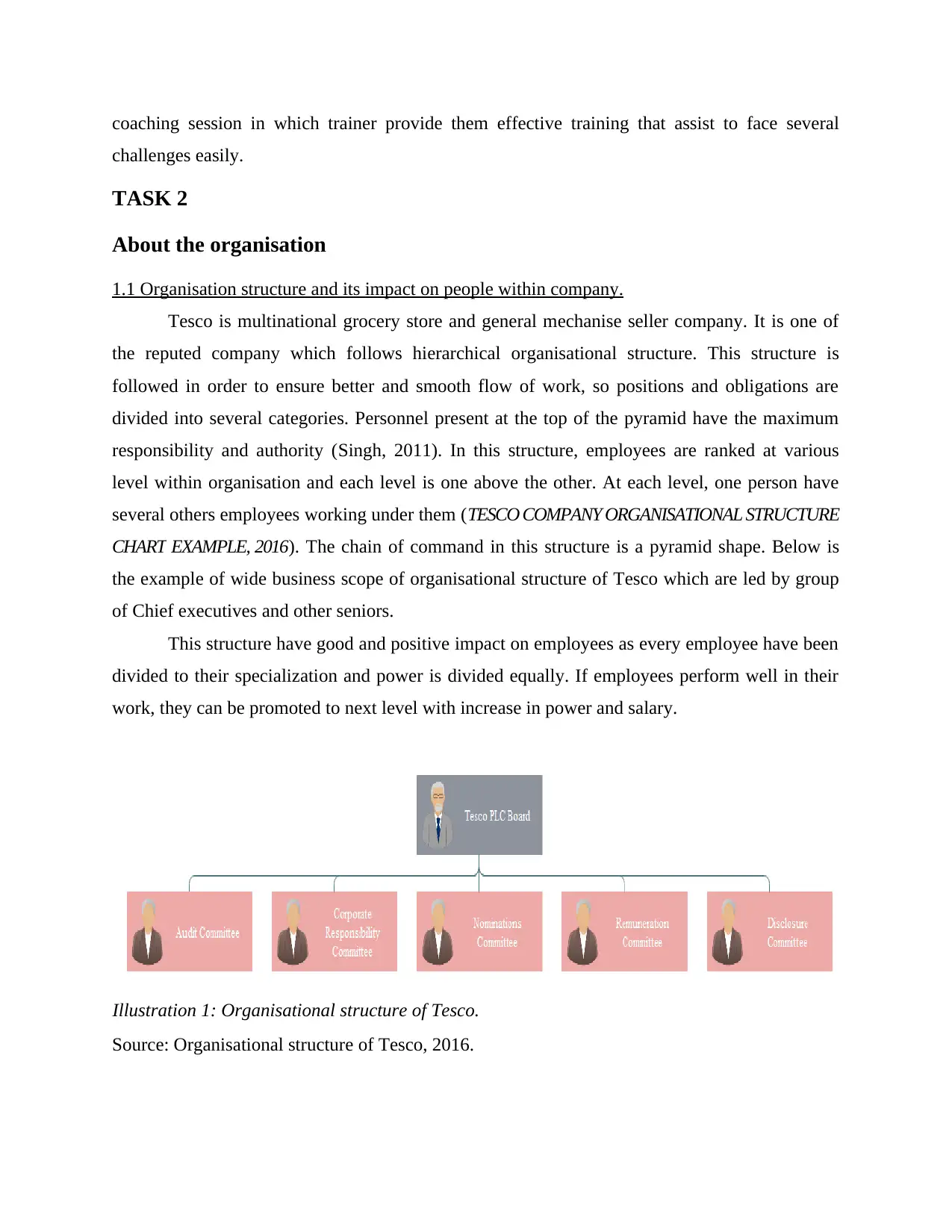
coaching session in which trainer provide them effective training that assist to face several
challenges easily.
TASK 2
About the organisation
1.1 Organisation structure and its impact on people within company.
Tesco is multinational grocery store and general mechanise seller company. It is one of
the reputed company which follows hierarchical organisational structure. This structure is
followed in order to ensure better and smooth flow of work, so positions and obligations are
divided into several categories. Personnel present at the top of the pyramid have the maximum
responsibility and authority (Singh, 2011). In this structure, employees are ranked at various
level within organisation and each level is one above the other. At each level, one person have
several others employees working under them (TESCO COMPANY ORGANISATIONAL STRUCTURE
CHART EXAMPLE, 2016). The chain of command in this structure is a pyramid shape. Below is
the example of wide business scope of organisational structure of Tesco which are led by group
of Chief executives and other seniors.
This structure have good and positive impact on employees as every employee have been
divided to their specialization and power is divided equally. If employees perform well in their
work, they can be promoted to next level with increase in power and salary.
Source: Organisational structure of Tesco, 2016.
Illustration 1: Organisational structure of Tesco.
challenges easily.
TASK 2
About the organisation
1.1 Organisation structure and its impact on people within company.
Tesco is multinational grocery store and general mechanise seller company. It is one of
the reputed company which follows hierarchical organisational structure. This structure is
followed in order to ensure better and smooth flow of work, so positions and obligations are
divided into several categories. Personnel present at the top of the pyramid have the maximum
responsibility and authority (Singh, 2011). In this structure, employees are ranked at various
level within organisation and each level is one above the other. At each level, one person have
several others employees working under them (TESCO COMPANY ORGANISATIONAL STRUCTURE
CHART EXAMPLE, 2016). The chain of command in this structure is a pyramid shape. Below is
the example of wide business scope of organisational structure of Tesco which are led by group
of Chief executives and other seniors.
This structure have good and positive impact on employees as every employee have been
divided to their specialization and power is divided equally. If employees perform well in their
work, they can be promoted to next level with increase in power and salary.
Source: Organisational structure of Tesco, 2016.
Illustration 1: Organisational structure of Tesco.
Paraphrase This Document
Need a fresh take? Get an instant paraphrase of this document with our AI Paraphraser
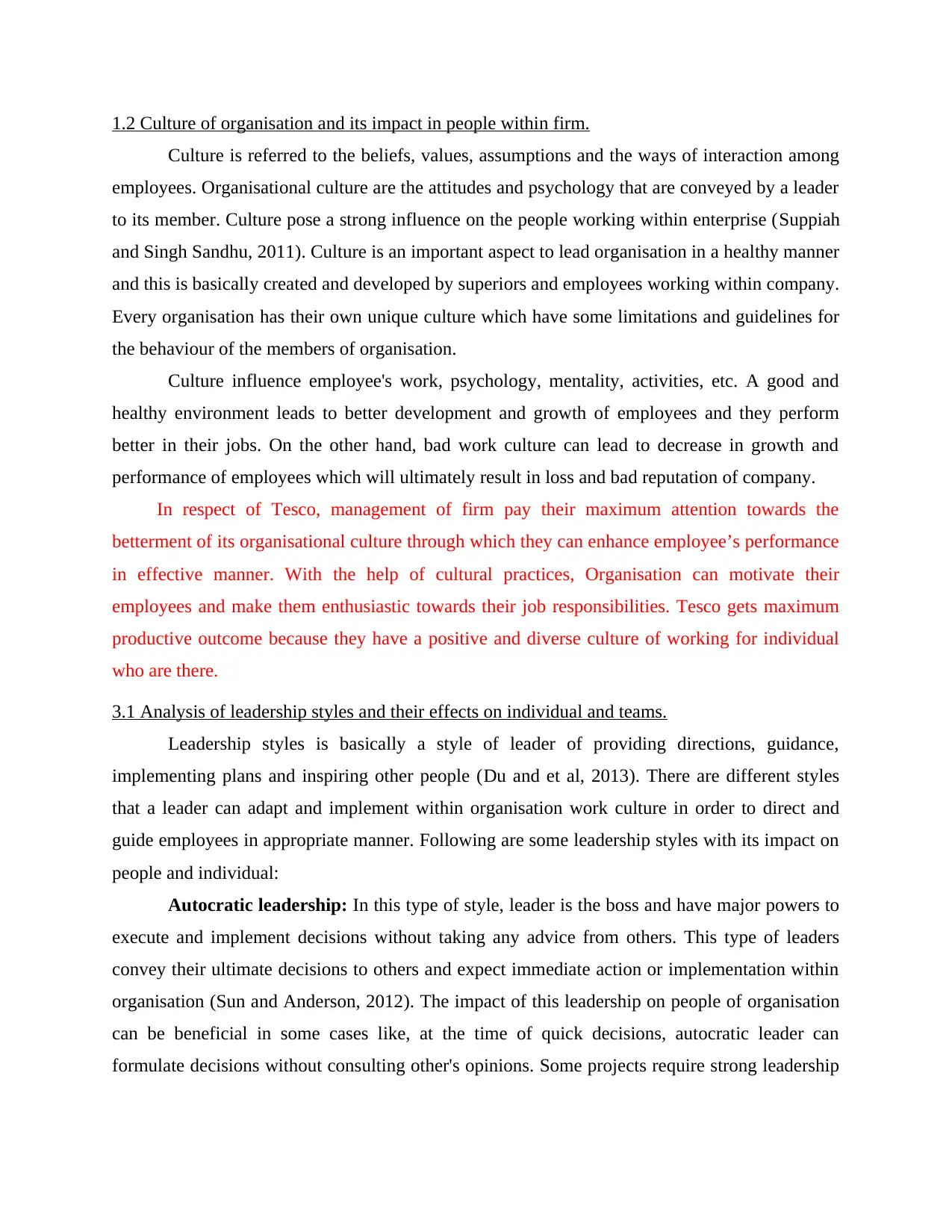
1.2 Culture of organisation and its impact in people within firm.
Culture is referred to the beliefs, values, assumptions and the ways of interaction among
employees. Organisational culture are the attitudes and psychology that are conveyed by a leader
to its member. Culture pose a strong influence on the people working within enterprise (Suppiah
and Singh Sandhu, 2011). Culture is an important aspect to lead organisation in a healthy manner
and this is basically created and developed by superiors and employees working within company.
Every organisation has their own unique culture which have some limitations and guidelines for
the behaviour of the members of organisation.
Culture influence employee's work, psychology, mentality, activities, etc. A good and
healthy environment leads to better development and growth of employees and they perform
better in their jobs. On the other hand, bad work culture can lead to decrease in growth and
performance of employees which will ultimately result in loss and bad reputation of company.
In respect of Tesco, management of firm pay their maximum attention towards the
betterment of its organisational culture through which they can enhance employee’s performance
in effective manner. With the help of cultural practices, Organisation can motivate their
employees and make them enthusiastic towards their job responsibilities. Tesco gets maximum
productive outcome because they have a positive and diverse culture of working for individual
who are there.
3.1 Analysis of leadership styles and their effects on individual and teams.
Leadership styles is basically a style of leader of providing directions, guidance,
implementing plans and inspiring other people (Du and et al, 2013). There are different styles
that a leader can adapt and implement within organisation work culture in order to direct and
guide employees in appropriate manner. Following are some leadership styles with its impact on
people and individual:
Autocratic leadership: In this type of style, leader is the boss and have major powers to
execute and implement decisions without taking any advice from others. This type of leaders
convey their ultimate decisions to others and expect immediate action or implementation within
organisation (Sun and Anderson, 2012). The impact of this leadership on people of organisation
can be beneficial in some cases like, at the time of quick decisions, autocratic leader can
formulate decisions without consulting other's opinions. Some projects require strong leadership
Culture is referred to the beliefs, values, assumptions and the ways of interaction among
employees. Organisational culture are the attitudes and psychology that are conveyed by a leader
to its member. Culture pose a strong influence on the people working within enterprise (Suppiah
and Singh Sandhu, 2011). Culture is an important aspect to lead organisation in a healthy manner
and this is basically created and developed by superiors and employees working within company.
Every organisation has their own unique culture which have some limitations and guidelines for
the behaviour of the members of organisation.
Culture influence employee's work, psychology, mentality, activities, etc. A good and
healthy environment leads to better development and growth of employees and they perform
better in their jobs. On the other hand, bad work culture can lead to decrease in growth and
performance of employees which will ultimately result in loss and bad reputation of company.
In respect of Tesco, management of firm pay their maximum attention towards the
betterment of its organisational culture through which they can enhance employee’s performance
in effective manner. With the help of cultural practices, Organisation can motivate their
employees and make them enthusiastic towards their job responsibilities. Tesco gets maximum
productive outcome because they have a positive and diverse culture of working for individual
who are there.
3.1 Analysis of leadership styles and their effects on individual and teams.
Leadership styles is basically a style of leader of providing directions, guidance,
implementing plans and inspiring other people (Du and et al, 2013). There are different styles
that a leader can adapt and implement within organisation work culture in order to direct and
guide employees in appropriate manner. Following are some leadership styles with its impact on
people and individual:
Autocratic leadership: In this type of style, leader is the boss and have major powers to
execute and implement decisions without taking any advice from others. This type of leaders
convey their ultimate decisions to others and expect immediate action or implementation within
organisation (Sun and Anderson, 2012). The impact of this leadership on people of organisation
can be beneficial in some cases like, at the time of quick decisions, autocratic leader can
formulate decisions without consulting other's opinions. Some projects require strong leadership
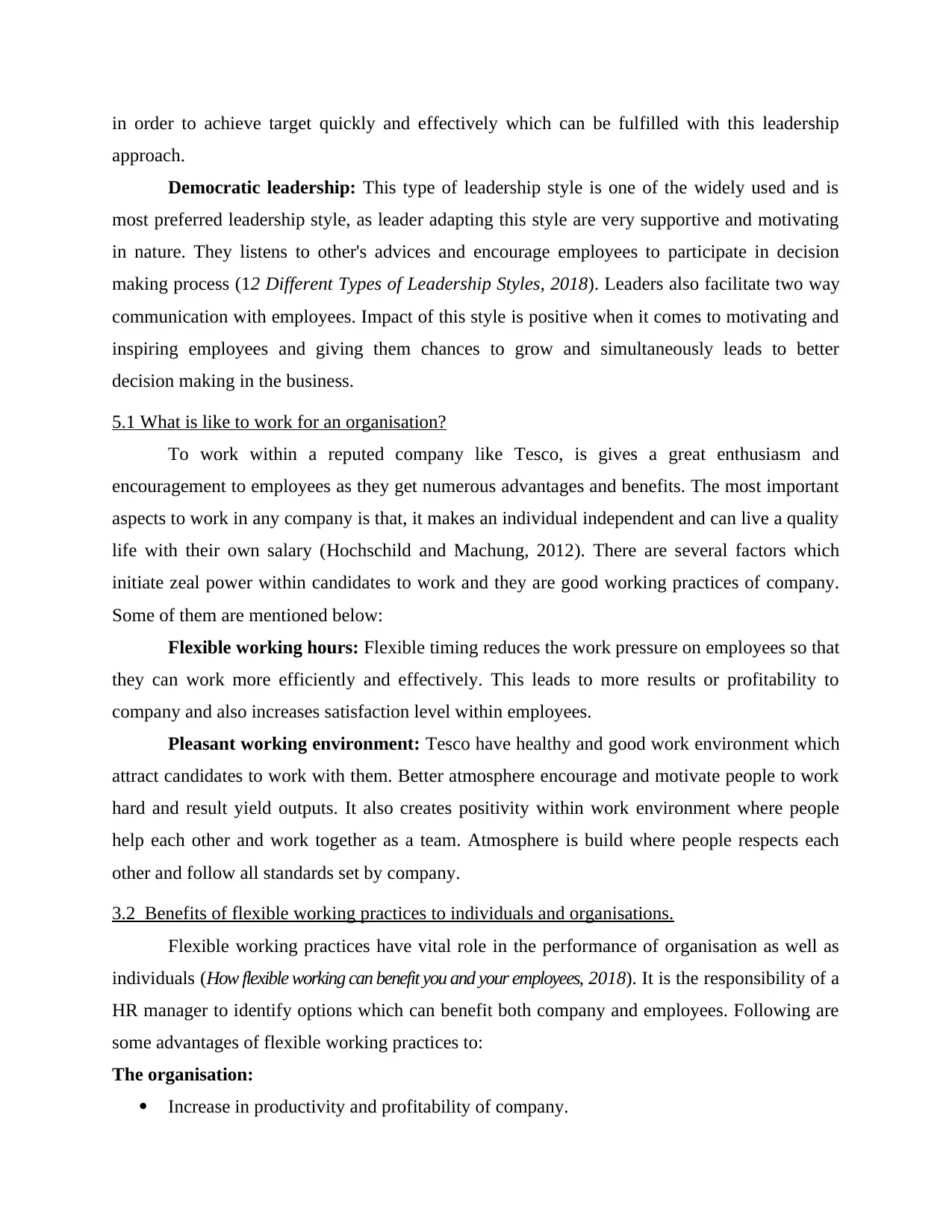
in order to achieve target quickly and effectively which can be fulfilled with this leadership
approach.
Democratic leadership: This type of leadership style is one of the widely used and is
most preferred leadership style, as leader adapting this style are very supportive and motivating
in nature. They listens to other's advices and encourage employees to participate in decision
making process (12 Different Types of Leadership Styles, 2018). Leaders also facilitate two way
communication with employees. Impact of this style is positive when it comes to motivating and
inspiring employees and giving them chances to grow and simultaneously leads to better
decision making in the business.
5.1 What is like to work for an organisation?
To work within a reputed company like Tesco, is gives a great enthusiasm and
encouragement to employees as they get numerous advantages and benefits. The most important
aspects to work in any company is that, it makes an individual independent and can live a quality
life with their own salary (Hochschild and Machung, 2012). There are several factors which
initiate zeal power within candidates to work and they are good working practices of company.
Some of them are mentioned below:
Flexible working hours: Flexible timing reduces the work pressure on employees so that
they can work more efficiently and effectively. This leads to more results or profitability to
company and also increases satisfaction level within employees.
Pleasant working environment: Tesco have healthy and good work environment which
attract candidates to work with them. Better atmosphere encourage and motivate people to work
hard and result yield outputs. It also creates positivity within work environment where people
help each other and work together as a team. Atmosphere is build where people respects each
other and follow all standards set by company.
3.2 Benefits of flexible working practices to individuals and organisations.
Flexible working practices have vital role in the performance of organisation as well as
individuals (How flexible working can benefit you and your employees, 2018). It is the responsibility of a
HR manager to identify options which can benefit both company and employees. Following are
some advantages of flexible working practices to:
The organisation:
Increase in productivity and profitability of company.
approach.
Democratic leadership: This type of leadership style is one of the widely used and is
most preferred leadership style, as leader adapting this style are very supportive and motivating
in nature. They listens to other's advices and encourage employees to participate in decision
making process (12 Different Types of Leadership Styles, 2018). Leaders also facilitate two way
communication with employees. Impact of this style is positive when it comes to motivating and
inspiring employees and giving them chances to grow and simultaneously leads to better
decision making in the business.
5.1 What is like to work for an organisation?
To work within a reputed company like Tesco, is gives a great enthusiasm and
encouragement to employees as they get numerous advantages and benefits. The most important
aspects to work in any company is that, it makes an individual independent and can live a quality
life with their own salary (Hochschild and Machung, 2012). There are several factors which
initiate zeal power within candidates to work and they are good working practices of company.
Some of them are mentioned below:
Flexible working hours: Flexible timing reduces the work pressure on employees so that
they can work more efficiently and effectively. This leads to more results or profitability to
company and also increases satisfaction level within employees.
Pleasant working environment: Tesco have healthy and good work environment which
attract candidates to work with them. Better atmosphere encourage and motivate people to work
hard and result yield outputs. It also creates positivity within work environment where people
help each other and work together as a team. Atmosphere is build where people respects each
other and follow all standards set by company.
3.2 Benefits of flexible working practices to individuals and organisations.
Flexible working practices have vital role in the performance of organisation as well as
individuals (How flexible working can benefit you and your employees, 2018). It is the responsibility of a
HR manager to identify options which can benefit both company and employees. Following are
some advantages of flexible working practices to:
The organisation:
Increase in productivity and profitability of company.
⊘ This is a preview!⊘
Do you want full access?
Subscribe today to unlock all pages.

Trusted by 1+ million students worldwide

More cost effectiveness and efficiency.
They have higher chances to attract good talents and skills.
The employees:
It reduces the stress and burden from employees as they can work as per their
convenience.
Increases the motivation and satisfaction level of the employees.
Increase in employee's productivity.
3.3 How working environment impacts on people performance.
Motivational theories are implemented within organisation in order to motivate and
inspire employees to achieve higher goals and aims in future (Raziq and Maulabakhsh, 2015).
With great motivation, people can perform better in their duties and can enhance their skills in
order to achieve objectives set by them or by company. Following is the motivation theory which
is given by McClelland and his associates and is known as McClelland's Need Theory.
This theory is associated with learning theory as McClelland believes that needs are
learned or acquired within time by people. This can be learned by experiences from their
environment and culture. Key elements of this theory are mentioned below:
Need for achievement: This need drives a person to achieve something great in life.
Within workforce, every employee work in order to accomplish something better in
future. Due to this reason, they work hard and compete with others.
Need for power: This is a desire that drives people to influence or impact others, desire
to change people and to make big differences in life. People having high need for power
like to be in control of certain people and events (Korzynski, 2013). In workplace, every
employees wants to get authority or power so that they can influence others with their
power. In order to fulfil this urge, they sometime leads wrong paths which can harm
others.
3.4 What are the ethical practices and CSR agendas in the organisation?
Corporate Social Responsibility (CSR) is a commitment of a company to contribute a
sustainable economic development, by working with employees, their families, local or regional
communities, societies at large in order to improve quality of life. Company integrates social and
environmental concerns within their business operations on a voluntary basis. Tesco have
implemented different Corporate Responsibility activities as a global, multichannel retailer in
They have higher chances to attract good talents and skills.
The employees:
It reduces the stress and burden from employees as they can work as per their
convenience.
Increases the motivation and satisfaction level of the employees.
Increase in employee's productivity.
3.3 How working environment impacts on people performance.
Motivational theories are implemented within organisation in order to motivate and
inspire employees to achieve higher goals and aims in future (Raziq and Maulabakhsh, 2015).
With great motivation, people can perform better in their duties and can enhance their skills in
order to achieve objectives set by them or by company. Following is the motivation theory which
is given by McClelland and his associates and is known as McClelland's Need Theory.
This theory is associated with learning theory as McClelland believes that needs are
learned or acquired within time by people. This can be learned by experiences from their
environment and culture. Key elements of this theory are mentioned below:
Need for achievement: This need drives a person to achieve something great in life.
Within workforce, every employee work in order to accomplish something better in
future. Due to this reason, they work hard and compete with others.
Need for power: This is a desire that drives people to influence or impact others, desire
to change people and to make big differences in life. People having high need for power
like to be in control of certain people and events (Korzynski, 2013). In workplace, every
employees wants to get authority or power so that they can influence others with their
power. In order to fulfil this urge, they sometime leads wrong paths which can harm
others.
3.4 What are the ethical practices and CSR agendas in the organisation?
Corporate Social Responsibility (CSR) is a commitment of a company to contribute a
sustainable economic development, by working with employees, their families, local or regional
communities, societies at large in order to improve quality of life. Company integrates social and
environmental concerns within their business operations on a voluntary basis. Tesco have
implemented different Corporate Responsibility activities as a global, multichannel retailer in
Paraphrase This Document
Need a fresh take? Get an instant paraphrase of this document with our AI Paraphraser

order to create goodwill and value for society (Arora and Dharwadkar, 2011). Their aim for this
CSR strategies is to tackle urgent issues such as food waste, health and youth development. This
activities motivates and inspire employees and work towards reducing the impact on
environment, support local communities, trade responsibly, etc. The employees who are part of
such responsible organisation feels determined and contribute to their full potential.
Ethics is a code of conduct that directs a person's or team's behaviour. Every senior
knows the importance of ethical practices so they implement those within organisation in order
to avoid failures. Ethics act as a catalyst to staff motivation and inspire them do pefrom better for
their organisation.
3.5 How the CSR agenda is used to motivate employees?
CSR are the best activities that motivates employees to do something for people of
society as well as for their organisation. Following are some ways through which employees can
be motivated through CSR:
Engagement of employees to improve CSR: Superiors can involve employees within
CSR activities and can share their vision of sustainability with them in order to inspire and
motivate them (Arora and Dharwadkar, 2011). By working with them, employee will perform
better and will contribute their part in development.
By providing benefits: If company is unable to attract employees within their CSR
activities, they can develop attractive benefits in order to motivate candidates to join CSR and
contribute their part to sustainability and development.
TASK 3
2.1 Explain how differences between people impacts on personal behaviour at workplace
Tesco is a leading grocery retailer in which numerous employees provide their quality
services and contribution for higher customer satisfaction. Though, management of firm always
face various differences between their employees that impacts on personal behaviour of others.
The differences can be arises due to skills, attitude and behaviour of a person which can impact
negatively or positively on others. These are the personal activeness of a person that assist to
make them different from any body else. Skill, attitude and Behaviour of a employees at work
often depend on how they feel and understand things differently. Every individual is different
from others, some might be more talented and unique in their own way of performing duties. due
CSR strategies is to tackle urgent issues such as food waste, health and youth development. This
activities motivates and inspire employees and work towards reducing the impact on
environment, support local communities, trade responsibly, etc. The employees who are part of
such responsible organisation feels determined and contribute to their full potential.
Ethics is a code of conduct that directs a person's or team's behaviour. Every senior
knows the importance of ethical practices so they implement those within organisation in order
to avoid failures. Ethics act as a catalyst to staff motivation and inspire them do pefrom better for
their organisation.
3.5 How the CSR agenda is used to motivate employees?
CSR are the best activities that motivates employees to do something for people of
society as well as for their organisation. Following are some ways through which employees can
be motivated through CSR:
Engagement of employees to improve CSR: Superiors can involve employees within
CSR activities and can share their vision of sustainability with them in order to inspire and
motivate them (Arora and Dharwadkar, 2011). By working with them, employee will perform
better and will contribute their part in development.
By providing benefits: If company is unable to attract employees within their CSR
activities, they can develop attractive benefits in order to motivate candidates to join CSR and
contribute their part to sustainability and development.
TASK 3
2.1 Explain how differences between people impacts on personal behaviour at workplace
Tesco is a leading grocery retailer in which numerous employees provide their quality
services and contribution for higher customer satisfaction. Though, management of firm always
face various differences between their employees that impacts on personal behaviour of others.
The differences can be arises due to skills, attitude and behaviour of a person which can impact
negatively or positively on others. These are the personal activeness of a person that assist to
make them different from any body else. Skill, attitude and Behaviour of a employees at work
often depend on how they feel and understand things differently. Every individual is different
from others, some might be more talented and unique in their own way of performing duties. due
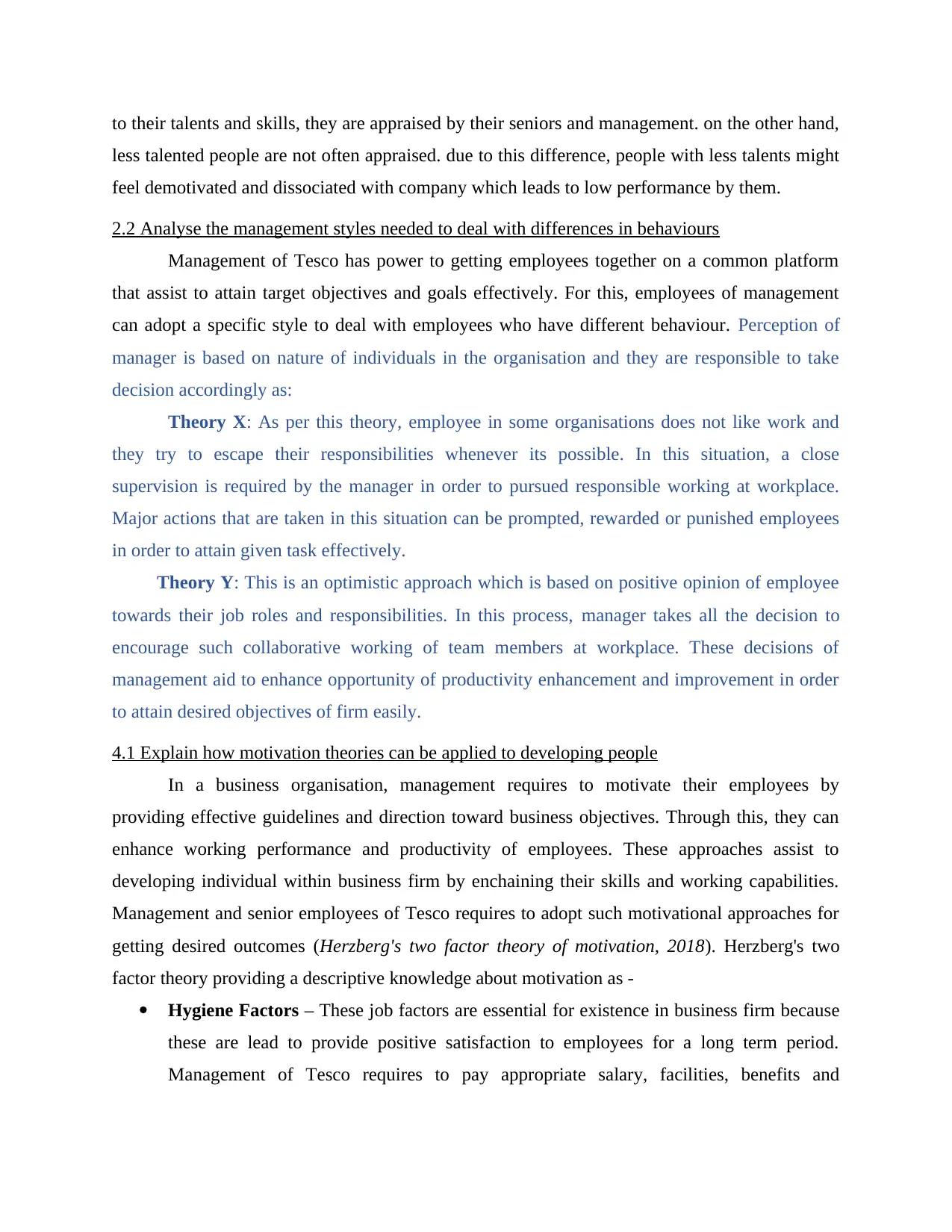
to their talents and skills, they are appraised by their seniors and management. on the other hand,
less talented people are not often appraised. due to this difference, people with less talents might
feel demotivated and dissociated with company which leads to low performance by them.
2.2 Analyse the management styles needed to deal with differences in behaviours
Management of Tesco has power to getting employees together on a common platform
that assist to attain target objectives and goals effectively. For this, employees of management
can adopt a specific style to deal with employees who have different behaviour. Perception of
manager is based on nature of individuals in the organisation and they are responsible to take
decision accordingly as:
Theory X: As per this theory, employee in some organisations does not like work and
they try to escape their responsibilities whenever its possible. In this situation, a close
supervision is required by the manager in order to pursued responsible working at workplace.
Major actions that are taken in this situation can be prompted, rewarded or punished employees
in order to attain given task effectively.
Theory Y: This is an optimistic approach which is based on positive opinion of employee
towards their job roles and responsibilities. In this process, manager takes all the decision to
encourage such collaborative working of team members at workplace. These decisions of
management aid to enhance opportunity of productivity enhancement and improvement in order
to attain desired objectives of firm easily.
4.1 Explain how motivation theories can be applied to developing people
In a business organisation, management requires to motivate their employees by
providing effective guidelines and direction toward business objectives. Through this, they can
enhance working performance and productivity of employees. These approaches assist to
developing individual within business firm by enchaining their skills and working capabilities.
Management and senior employees of Tesco requires to adopt such motivational approaches for
getting desired outcomes (Herzberg's two factor theory of motivation, 2018). Herzberg's two
factor theory providing a descriptive knowledge about motivation as -
Hygiene Factors – These job factors are essential for existence in business firm because
these are lead to provide positive satisfaction to employees for a long term period.
Management of Tesco requires to pay appropriate salary, facilities, benefits and
less talented people are not often appraised. due to this difference, people with less talents might
feel demotivated and dissociated with company which leads to low performance by them.
2.2 Analyse the management styles needed to deal with differences in behaviours
Management of Tesco has power to getting employees together on a common platform
that assist to attain target objectives and goals effectively. For this, employees of management
can adopt a specific style to deal with employees who have different behaviour. Perception of
manager is based on nature of individuals in the organisation and they are responsible to take
decision accordingly as:
Theory X: As per this theory, employee in some organisations does not like work and
they try to escape their responsibilities whenever its possible. In this situation, a close
supervision is required by the manager in order to pursued responsible working at workplace.
Major actions that are taken in this situation can be prompted, rewarded or punished employees
in order to attain given task effectively.
Theory Y: This is an optimistic approach which is based on positive opinion of employee
towards their job roles and responsibilities. In this process, manager takes all the decision to
encourage such collaborative working of team members at workplace. These decisions of
management aid to enhance opportunity of productivity enhancement and improvement in order
to attain desired objectives of firm easily.
4.1 Explain how motivation theories can be applied to developing people
In a business organisation, management requires to motivate their employees by
providing effective guidelines and direction toward business objectives. Through this, they can
enhance working performance and productivity of employees. These approaches assist to
developing individual within business firm by enchaining their skills and working capabilities.
Management and senior employees of Tesco requires to adopt such motivational approaches for
getting desired outcomes (Herzberg's two factor theory of motivation, 2018). Herzberg's two
factor theory providing a descriptive knowledge about motivation as -
Hygiene Factors – These job factors are essential for existence in business firm because
these are lead to provide positive satisfaction to employees for a long term period.
Management of Tesco requires to pay appropriate salary, facilities, benefits and
⊘ This is a preview!⊘
Do you want full access?
Subscribe today to unlock all pages.

Trusted by 1+ million students worldwide
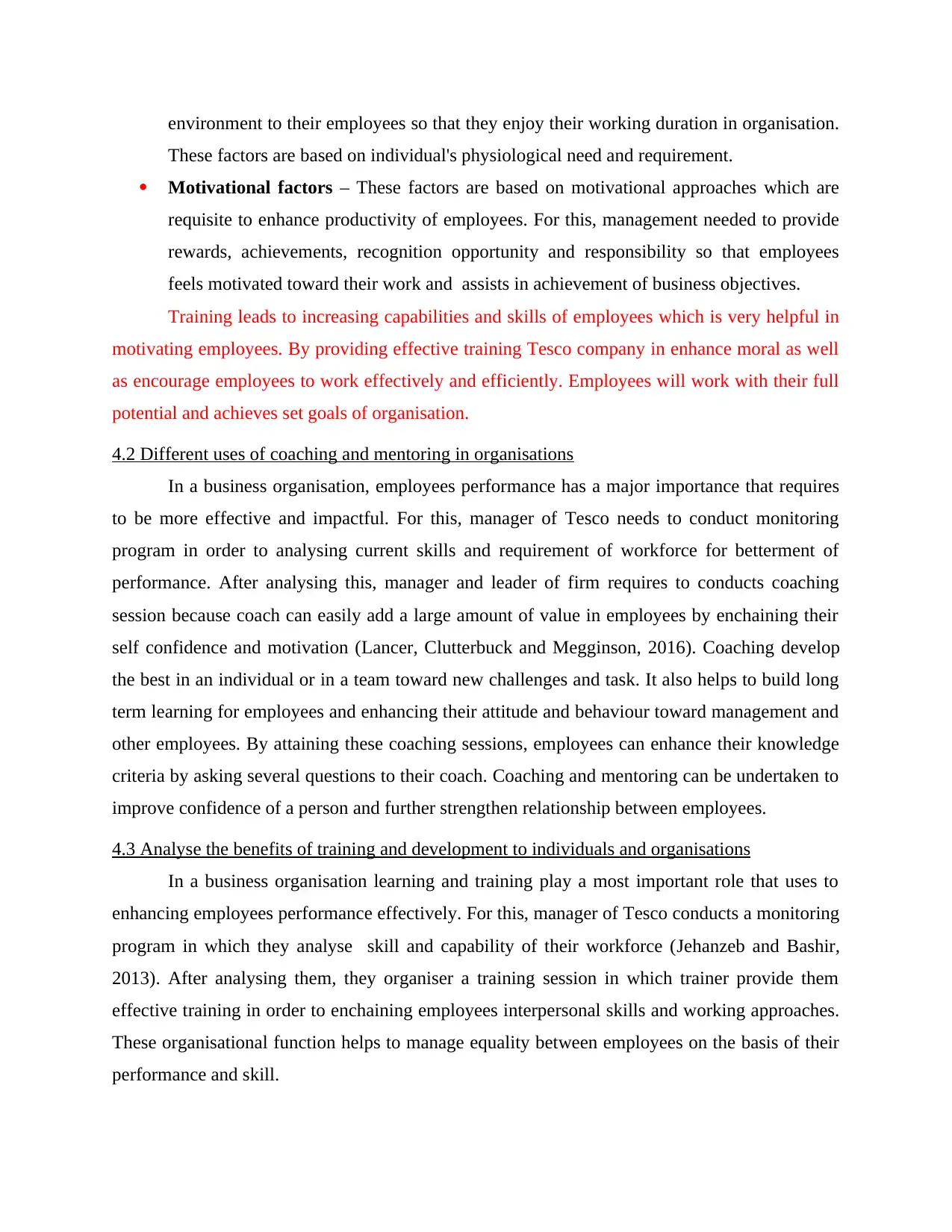
environment to their employees so that they enjoy their working duration in organisation.
These factors are based on individual's physiological need and requirement.
Motivational factors – These factors are based on motivational approaches which are
requisite to enhance productivity of employees. For this, management needed to provide
rewards, achievements, recognition opportunity and responsibility so that employees
feels motivated toward their work and assists in achievement of business objectives.
Training leads to increasing capabilities and skills of employees which is very helpful in
motivating employees. By providing effective training Tesco company in enhance moral as well
as encourage employees to work effectively and efficiently. Employees will work with their full
potential and achieves set goals of organisation.
4.2 Different uses of coaching and mentoring in organisations
In a business organisation, employees performance has a major importance that requires
to be more effective and impactful. For this, manager of Tesco needs to conduct monitoring
program in order to analysing current skills and requirement of workforce for betterment of
performance. After analysing this, manager and leader of firm requires to conducts coaching
session because coach can easily add a large amount of value in employees by enchaining their
self confidence and motivation (Lancer, Clutterbuck and Megginson, 2016). Coaching develop
the best in an individual or in a team toward new challenges and task. It also helps to build long
term learning for employees and enhancing their attitude and behaviour toward management and
other employees. By attaining these coaching sessions, employees can enhance their knowledge
criteria by asking several questions to their coach. Coaching and mentoring can be undertaken to
improve confidence of a person and further strengthen relationship between employees.
4.3 Analyse the benefits of training and development to individuals and organisations
In a business organisation learning and training play a most important role that uses to
enhancing employees performance effectively. For this, manager of Tesco conducts a monitoring
program in which they analyse skill and capability of their workforce (Jehanzeb and Bashir,
2013). After analysing them, they organiser a training session in which trainer provide them
effective training in order to enchaining employees interpersonal skills and working approaches.
These organisational function helps to manage equality between employees on the basis of their
performance and skill.
These factors are based on individual's physiological need and requirement.
Motivational factors – These factors are based on motivational approaches which are
requisite to enhance productivity of employees. For this, management needed to provide
rewards, achievements, recognition opportunity and responsibility so that employees
feels motivated toward their work and assists in achievement of business objectives.
Training leads to increasing capabilities and skills of employees which is very helpful in
motivating employees. By providing effective training Tesco company in enhance moral as well
as encourage employees to work effectively and efficiently. Employees will work with their full
potential and achieves set goals of organisation.
4.2 Different uses of coaching and mentoring in organisations
In a business organisation, employees performance has a major importance that requires
to be more effective and impactful. For this, manager of Tesco needs to conduct monitoring
program in order to analysing current skills and requirement of workforce for betterment of
performance. After analysing this, manager and leader of firm requires to conducts coaching
session because coach can easily add a large amount of value in employees by enchaining their
self confidence and motivation (Lancer, Clutterbuck and Megginson, 2016). Coaching develop
the best in an individual or in a team toward new challenges and task. It also helps to build long
term learning for employees and enhancing their attitude and behaviour toward management and
other employees. By attaining these coaching sessions, employees can enhance their knowledge
criteria by asking several questions to their coach. Coaching and mentoring can be undertaken to
improve confidence of a person and further strengthen relationship between employees.
4.3 Analyse the benefits of training and development to individuals and organisations
In a business organisation learning and training play a most important role that uses to
enhancing employees performance effectively. For this, manager of Tesco conducts a monitoring
program in which they analyse skill and capability of their workforce (Jehanzeb and Bashir,
2013). After analysing them, they organiser a training session in which trainer provide them
effective training in order to enchaining employees interpersonal skills and working approaches.
These organisational function helps to manage equality between employees on the basis of their
performance and skill.
Paraphrase This Document
Need a fresh take? Get an instant paraphrase of this document with our AI Paraphraser
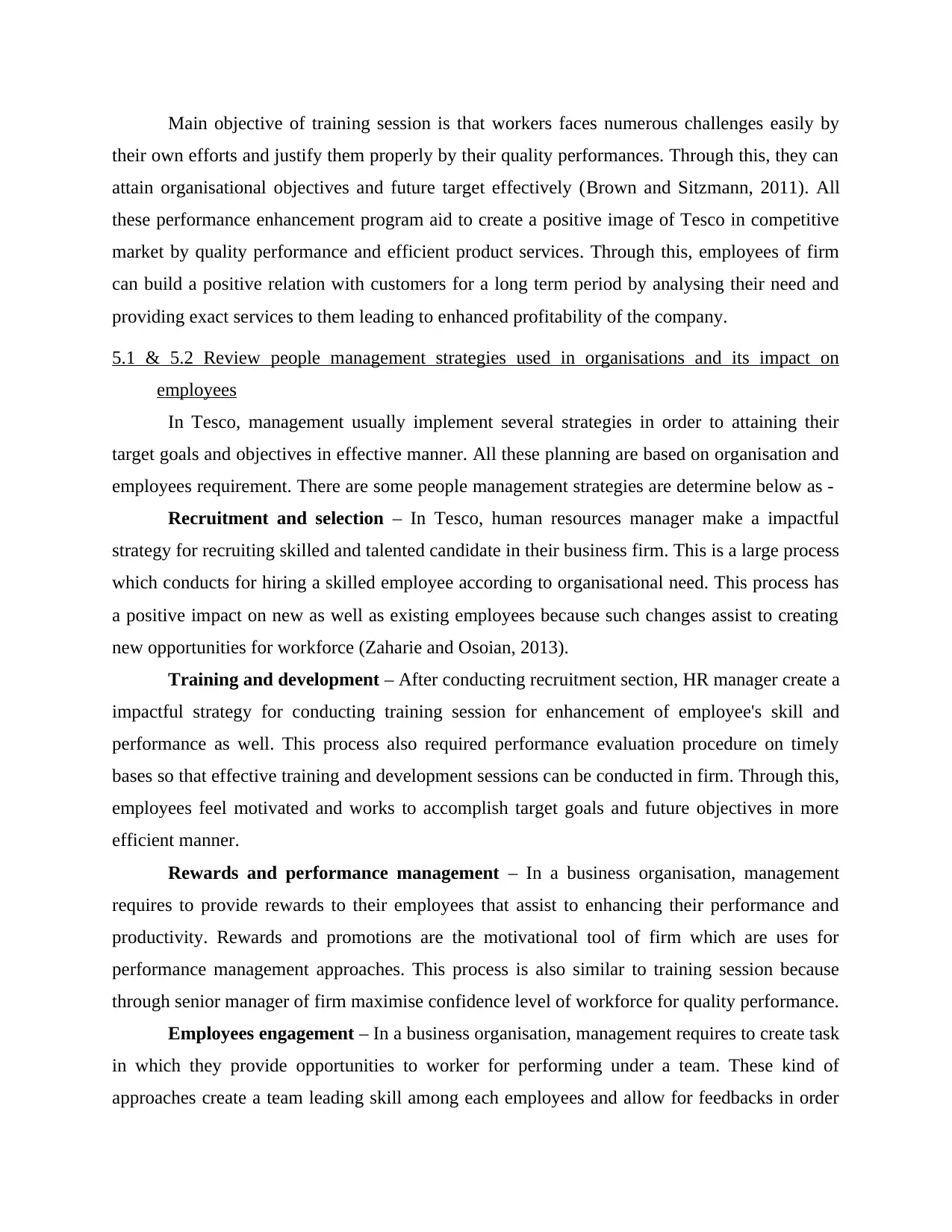
Main objective of training session is that workers faces numerous challenges easily by
their own efforts and justify them properly by their quality performances. Through this, they can
attain organisational objectives and future target effectively (Brown and Sitzmann, 2011). All
these performance enhancement program aid to create a positive image of Tesco in competitive
market by quality performance and efficient product services. Through this, employees of firm
can build a positive relation with customers for a long term period by analysing their need and
providing exact services to them leading to enhanced profitability of the company.
5.1 & 5.2 Review people management strategies used in organisations and its impact on
employees
In Tesco, management usually implement several strategies in order to attaining their
target goals and objectives in effective manner. All these planning are based on organisation and
employees requirement. There are some people management strategies are determine below as -
Recruitment and selection – In Tesco, human resources manager make a impactful
strategy for recruiting skilled and talented candidate in their business firm. This is a large process
which conducts for hiring a skilled employee according to organisational need. This process has
a positive impact on new as well as existing employees because such changes assist to creating
new opportunities for workforce (Zaharie and Osoian, 2013).
Training and development – After conducting recruitment section, HR manager create a
impactful strategy for conducting training session for enhancement of employee's skill and
performance as well. This process also required performance evaluation procedure on timely
bases so that effective training and development sessions can be conducted in firm. Through this,
employees feel motivated and works to accomplish target goals and future objectives in more
efficient manner.
Rewards and performance management – In a business organisation, management
requires to provide rewards to their employees that assist to enhancing their performance and
productivity. Rewards and promotions are the motivational tool of firm which are uses for
performance management approaches. This process is also similar to training session because
through senior manager of firm maximise confidence level of workforce for quality performance.
Employees engagement – In a business organisation, management requires to create task
in which they provide opportunities to worker for performing under a team. These kind of
approaches create a team leading skill among each employees and allow for feedbacks in order
their own efforts and justify them properly by their quality performances. Through this, they can
attain organisational objectives and future target effectively (Brown and Sitzmann, 2011). All
these performance enhancement program aid to create a positive image of Tesco in competitive
market by quality performance and efficient product services. Through this, employees of firm
can build a positive relation with customers for a long term period by analysing their need and
providing exact services to them leading to enhanced profitability of the company.
5.1 & 5.2 Review people management strategies used in organisations and its impact on
employees
In Tesco, management usually implement several strategies in order to attaining their
target goals and objectives in effective manner. All these planning are based on organisation and
employees requirement. There are some people management strategies are determine below as -
Recruitment and selection – In Tesco, human resources manager make a impactful
strategy for recruiting skilled and talented candidate in their business firm. This is a large process
which conducts for hiring a skilled employee according to organisational need. This process has
a positive impact on new as well as existing employees because such changes assist to creating
new opportunities for workforce (Zaharie and Osoian, 2013).
Training and development – After conducting recruitment section, HR manager create a
impactful strategy for conducting training session for enhancement of employee's skill and
performance as well. This process also required performance evaluation procedure on timely
bases so that effective training and development sessions can be conducted in firm. Through this,
employees feel motivated and works to accomplish target goals and future objectives in more
efficient manner.
Rewards and performance management – In a business organisation, management
requires to provide rewards to their employees that assist to enhancing their performance and
productivity. Rewards and promotions are the motivational tool of firm which are uses for
performance management approaches. This process is also similar to training session because
through senior manager of firm maximise confidence level of workforce for quality performance.
Employees engagement – In a business organisation, management requires to create task
in which they provide opportunities to worker for performing under a team. These kind of
approaches create a team leading skill among each employees and allow for feedbacks in order
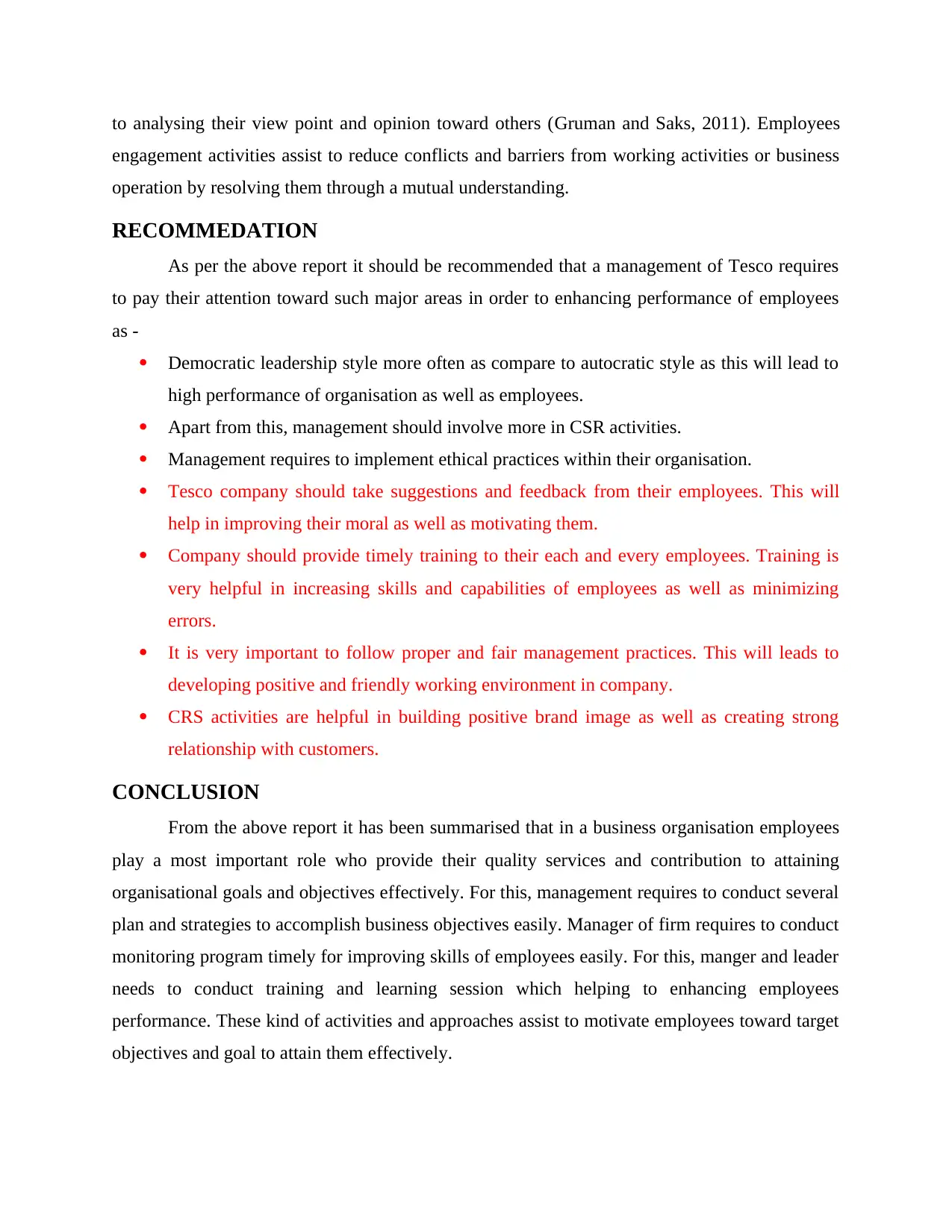
to analysing their view point and opinion toward others (Gruman and Saks, 2011). Employees
engagement activities assist to reduce conflicts and barriers from working activities or business
operation by resolving them through a mutual understanding.
RECOMMEDATION
As per the above report it should be recommended that a management of Tesco requires
to pay their attention toward such major areas in order to enhancing performance of employees
as -
Democratic leadership style more often as compare to autocratic style as this will lead to
high performance of organisation as well as employees.
Apart from this, management should involve more in CSR activities.
Management requires to implement ethical practices within their organisation.
Tesco company should take suggestions and feedback from their employees. This will
help in improving their moral as well as motivating them.
Company should provide timely training to their each and every employees. Training is
very helpful in increasing skills and capabilities of employees as well as minimizing
errors.
It is very important to follow proper and fair management practices. This will leads to
developing positive and friendly working environment in company.
CRS activities are helpful in building positive brand image as well as creating strong
relationship with customers.
CONCLUSION
From the above report it has been summarised that in a business organisation employees
play a most important role who provide their quality services and contribution to attaining
organisational goals and objectives effectively. For this, management requires to conduct several
plan and strategies to accomplish business objectives easily. Manager of firm requires to conduct
monitoring program timely for improving skills of employees easily. For this, manger and leader
needs to conduct training and learning session which helping to enhancing employees
performance. These kind of activities and approaches assist to motivate employees toward target
objectives and goal to attain them effectively.
engagement activities assist to reduce conflicts and barriers from working activities or business
operation by resolving them through a mutual understanding.
RECOMMEDATION
As per the above report it should be recommended that a management of Tesco requires
to pay their attention toward such major areas in order to enhancing performance of employees
as -
Democratic leadership style more often as compare to autocratic style as this will lead to
high performance of organisation as well as employees.
Apart from this, management should involve more in CSR activities.
Management requires to implement ethical practices within their organisation.
Tesco company should take suggestions and feedback from their employees. This will
help in improving their moral as well as motivating them.
Company should provide timely training to their each and every employees. Training is
very helpful in increasing skills and capabilities of employees as well as minimizing
errors.
It is very important to follow proper and fair management practices. This will leads to
developing positive and friendly working environment in company.
CRS activities are helpful in building positive brand image as well as creating strong
relationship with customers.
CONCLUSION
From the above report it has been summarised that in a business organisation employees
play a most important role who provide their quality services and contribution to attaining
organisational goals and objectives effectively. For this, management requires to conduct several
plan and strategies to accomplish business objectives easily. Manager of firm requires to conduct
monitoring program timely for improving skills of employees easily. For this, manger and leader
needs to conduct training and learning session which helping to enhancing employees
performance. These kind of activities and approaches assist to motivate employees toward target
objectives and goal to attain them effectively.
⊘ This is a preview!⊘
Do you want full access?
Subscribe today to unlock all pages.

Trusted by 1+ million students worldwide
1 out of 14
Related Documents
Your All-in-One AI-Powered Toolkit for Academic Success.
+13062052269
info@desklib.com
Available 24*7 on WhatsApp / Email
![[object Object]](/_next/static/media/star-bottom.7253800d.svg)
Unlock your academic potential
Copyright © 2020–2025 A2Z Services. All Rights Reserved. Developed and managed by ZUCOL.





